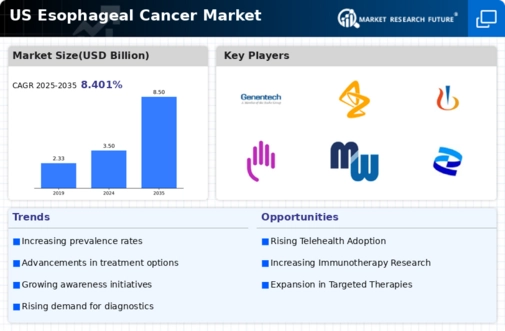Rising Incidence Rates
The esophageal cancer market is experiencing growth due to the rising incidence rates of the disease in the US. Recent statistics indicate that the number of new cases has increased, with an estimated 20,640 new diagnoses expected in 2025. This trend is likely driven by factors such as lifestyle changes, including increased rates of obesity and gastroesophageal reflux disease (GERD). As the population ages, the risk of developing esophageal cancer also escalates, further contributing to the market's expansion. The growing patient population necessitates advancements in treatment options and healthcare services, thereby stimulating the esophageal cancer market. Furthermore, the increasing awareness of the disease among healthcare professionals and patients may lead to earlier diagnosis and treatment, which could positively impact survival rates and market growth.
Increased Research Funding
The esophageal cancer market is benefiting from increased research funding aimed at understanding the disease better and developing new treatment strategies. Government and private organizations are allocating substantial resources to support research initiatives, which may lead to breakthroughs in early detection and treatment. In 2025, funding for cancer research is expected to exceed $6 billion, with a portion specifically directed towards esophageal cancer studies. This influx of financial support is likely to accelerate the pace of clinical trials and the development of innovative therapies. Moreover, collaborations between academic institutions and pharmaceutical companies are becoming more common, fostering an environment conducive to scientific discovery. As a result, the esophageal cancer market may experience significant advancements in therapeutic options and improved patient outcomes.
Growing Awareness and Education
The esophageal cancer market is witnessing a surge in awareness and education initiatives aimed at both healthcare professionals and the general public. Campaigns focused on risk factors, symptoms, and the importance of early detection are becoming increasingly prevalent. Organizations dedicated to cancer awareness are actively promoting educational resources, which may lead to earlier diagnosis and treatment. As awareness increases, more individuals are likely to seek medical attention for symptoms associated with esophageal cancer, potentially resulting in higher diagnosis rates. This heightened awareness could also drive demand for screening and diagnostic services, further propelling the growth of the esophageal cancer market. In 2025, it is anticipated that educational initiatives will continue to expand, fostering a more informed population regarding esophageal cancer.
Advancements in Treatment Modalities
Innovations in treatment modalities are significantly influencing the esophageal cancer market. The development of novel therapies, including immunotherapy and targeted therapies, has transformed the treatment landscape. For instance, the introduction of immune checkpoint inhibitors has shown promising results in clinical trials, leading to improved patient outcomes. The market is projected to reach approximately $3.5 billion by 2026, reflecting the growing demand for effective treatment options. Additionally, the integration of personalized medicine approaches allows for tailored therapies based on individual patient profiles, enhancing treatment efficacy. As research continues to unveil new therapeutic targets, the esophageal cancer market is likely to witness further advancements, ultimately benefiting patients and healthcare providers alike.
Technological Innovations in Diagnostics
Technological innovations in diagnostics are playing a crucial role in shaping the esophageal cancer market. Advances in imaging techniques, such as endoscopic ultrasound and high-resolution endoscopy, are enhancing the accuracy of diagnosis. These technologies allow for earlier detection of esophageal cancer, which is critical for improving patient outcomes. The market for diagnostic tools is projected to grow significantly, with estimates suggesting a value of $1.2 billion by 2026. Furthermore, the integration of artificial intelligence in diagnostic processes is expected to streamline workflows and improve the precision of cancer detection. As these technologies become more widely adopted, the esophageal cancer market is likely to benefit from increased efficiency in diagnosis and treatment planning, ultimately leading to better patient care.

















Leave a Comment